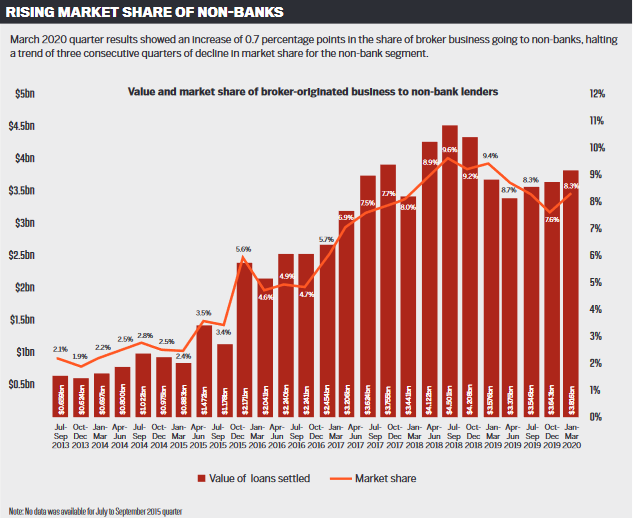Non-banks are stepping up to the plate as brokers look for alternative solutions to help borrowers

The importance of of near prime lending has become increasingly clear over the last few years, but the effects of the global pandemic may have highlighted it even more. Many Australians, alongside much of the rest of the world, have experienced job losses, salary cuts and business shutdowns during COVID-19. As banks and non-banks rushed to help their customers with various relief packages at the onset of the pandemic, several had to pull back from new lending, and those that continued to lend did so with tighter scrutiny.
ABS figures show that the unemployment rate rose to a high of 7.5% in July 2020. Even for those who continued in employment, the hours they worked dropped by more than 10% on average from March to May.
There is a misconception that near prime lending is just for borrowers with impaired credit. However, many borrowers impacted by these reduced hours and job changes will benefit from such lending.
La Trobe Financial chief lending officer Cory Bannister says that even those who won’t face an immediate credit impairment if they have lost their jobs – either because they are ahead on their repayments or have cash reserves – could end up outside the banks’ lending criteria.
“That sudden change to employment or a need to hold on to casual sources of income will mean they are probably determined to be near prime,” he says.
“I think COVID-19 will see an increase in near prime customers and really underscore the need to service that segment of the market.”
Over Bannister’s 21 years in the lending industry, he says that while there has been “plenty of change” – with the GFC and COVID-19 creating two critical credit events, and changes to regulations and lender policy – the fundamentals have remained the same.
“We still look to the 5 C’s of lending: character, capital, capacity, collateral and conditions. We work through those, and if it makes sense, it’s a deal that we want to do,” he says. “More recently, though, the biggest trend in near prime lending has been the persistent tightening of the bank acceptance criteria that has caused much confusion and uncertainty for borrowers and is in turn driving more business to brokers, which has been validating the broker-to-non-bank value proposition.”
Taking a real-life approach
Pepper has also seen growing segments of the market turn to near prime loans as the traditional banks change their lending criteria. Aaron Milburn, general manager of mortgages and commercial lending at Pepper, says banks’ criteria don’t reflect “real life” in determining whether someone is eligible for a loan based on how they prove their income.
The non-bank “pioneered” its near prime product in 2014 to cater for those customers who were unable to secure lending from the major banks, but Milburn says the market has not moved forward much further since then.

“From the point of view of self-employed customers, near prime lending is the fastest-growing sector in our industry – they simply cannot take advantage of the rates and promotions on offer from the major banks, given the way they verify their income,” Milburn says.
There are multiple reasons why borrowers need near prime loans. Broker at iChoice Maroun Ajaka says he deals with borrowers who have inconsistent income or growing businesses with tax returns or historic income that do not reflect the true situation; tax returns that are not up to date; defaults; short-term self-employment; or the need for debt consolidation and greater borrowing capacity.
In the time that Ajaka has been writing near prime loans he has seen some good changes. He writes deals with Pepper, which he says provides a “continually evolving matrix” to identify whether a client qualifies for near prime.
Not only that but he says customers are much more aware of the near prime solution now than they were before.
“Over time my clients have become more educated on the product via communication with me and past applications we have lodged for them and their families,” he says. “They now come to me and say, ‘Can we do this as an alt-doc?’, whereas previously it was always me making the suggestion.”
It also helps that interest rates are at an all-time low. “Although rates across the board are low, we never would have guessed two years ago that we could offer alt-doc/near prime rates under 4%,” Ajaka says.
Helping near prime borrowers access finance
As customers become more aware of the option of near prime loans, brokers should also be more comfortable in offering them as a solution. At this time of uncertainty and stress due to COVID-19, Bannister says there will be opportunities for brokers to step in and forge strong relationships with borrowers.
“People never forget those who help them or stand by them in their time of need, and near prime borrowers fit that mode extremely well,” he says.
Bannister says brokers with near prime customers should follow five key steps.
“The first would be to listen carefully and keep an open mind; there is always a solution that can be found,” he explains.
“Secondly, ask for the whole truth from the borrowers about their financial objectives and positions; it enables us to help tailor the solution.
“Third, complete your reasonableness tests on standard income and expenditure. Get that done early, making sure that what the customer has stated is reasonable for their age, their sector, their industry and their time of employment, etc.
“Then educate clients about their options, both now and in the future. If they are a little bit doubtful, you need to talk to them about the longer journey: the near prime offering might be a point in time or a path to a more mainstream future.
“Lastly, speak to the lender early in the process and run scenarios by them and get some confidence around the transaction before you lodge it.”
While there is still some trepidation among brokers around near prime lending, Milburn reassures them that borrowers who are self-employed are no more at risk than PAYG customers, even though some lenders may deem them to be.
“Just because a customer proves how they earn their income differently to someone who is employed by an institution or a company does not mean that they are a heightened risk or that they don’t deserve to achieve the goal of homeownership,” he says.
Milburn says near prime has been a cornerstone product for the non-bank since 2014 and will continue to be important for Pepper in 2021 and beyond.
“In helping more families achieve their goals of homeownership or just bettering the financial situation they find themselves in, near prime is key,” he says.
Looking ahead at 2021
Expecting the year ahead to be “interesting”, Bannister says the recovery will probably be non-linear, with reverberations felt throughout the economy over the next two to three years.
“We think there is a strong possibility the near prime proposition will be further increased as borrowers have been directly or indirectly impacted by the COVID-19 pandemic already and the impacts will continue to emerge over time, post government assistance and stimulus,” he says.
“Where we anticipate some potential problems is in what happens down the line. It may be in October 2021 or November 2021 that a borrower actually has a credit issue that stems from a change as a result of COVID-19. How are lenders going to deal with those particular delayed impacts of COVID-19? That’s where I think non-bank financial institutions and brokers are terrifically positioned to handle that.”



